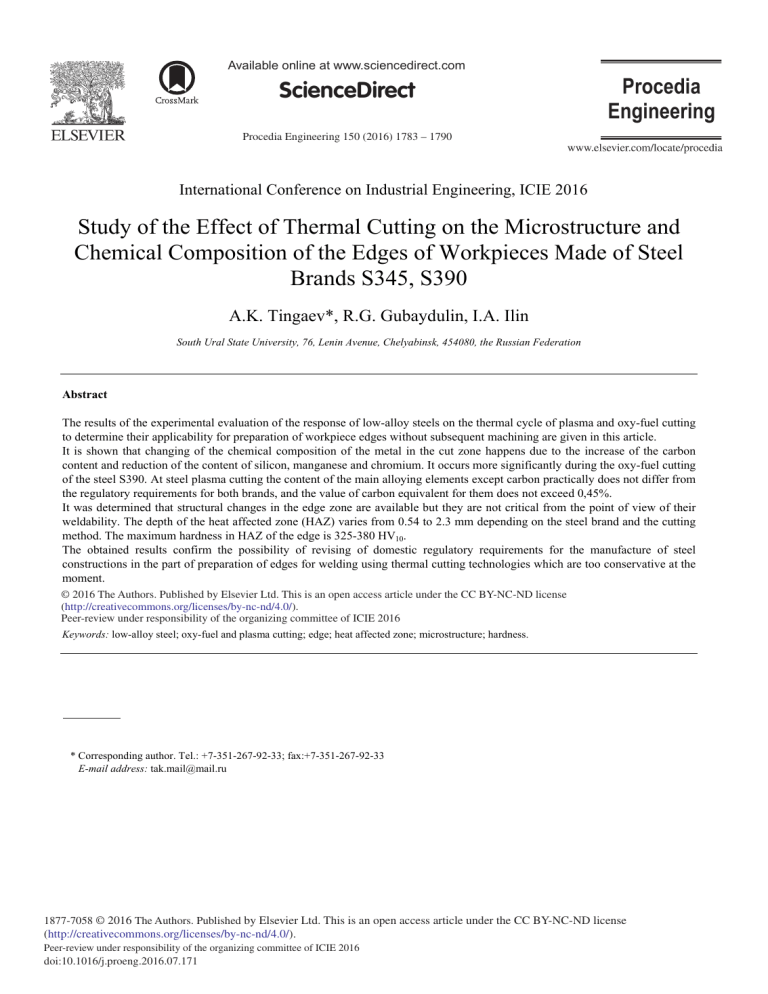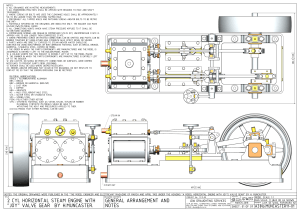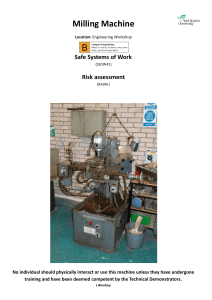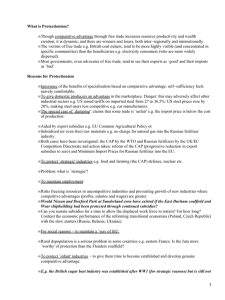
Available online at www.sciencedirect.com ScienceDirect Procedia Engineering 150 (2016) 1783 – 1790 International Conference on Industrial Engineering, ICIE 2016 Study of the Effect of Thermal Cutting on the Microstructure and Chemical Composition of the Edges of Workpieces Made of Steel Brands S345, S390 A.K. Tingaev*, R.G. Gubaydulin, I.A. Ilin South Ural State University, 76, Lenin Avenue, Chelyabinsk, 454080, the Russian Federation Abstract The results of the experimental evaluation of the response of low-alloy steels on the thermal cycle of plasma and oxy-fuel cutting to determine their applicability for preparation of workpiece edges without subsequent machining are given in this article. It is shown that changing of the chemical composition of the metal in the cut zone happens due to the increase of the carbon content and reduction of the content of silicon, manganese and chromium. It occurs more significantly during the oxy-fuel cutting of the steel S390. At steel plasma cutting the content of the main alloying elements except carbon practically does not differ from the regulatory requirements for both brands, and the value of carbon equivalent for them does not exceed 0,45%. It was determined that structural changes in the edge zone are available but they are not critical from the point of view of their weldability. The depth of the heat affected zone (HAZ) varies from 0.54 to 2.3 mm depending on the steel brand and the cutting method. The maximum hardness in HAZ of the edge is 325-380 HV10. The obtained results confirm the possibility of revising of domestic regulatory requirements for the manufacture of steel constructions in the part of preparation of edges for welding using thermal cutting technologies which are too conservative at the moment. © 2016 2016The TheAuthors. Authors. Published Elsevier © Published by by Elsevier Ltd.Ltd. This is an open access article under the CC BY-NC-ND license (http://creativecommons.org/licenses/by-nc-nd/4.0/). Peer-review under responsibility of the organizing committee of ICIE 2016. Peer-review under responsibility of the organizing committee of ICIE 2016 Keywords: low-alloy steel; oxy-fuel and plasma cutting; edge; heat affected zone; microstructure; hardness. * Corresponding author. Tel.: +7-351-267-92-33; fax:+7-351-267-92-33 E-mail address: [email protected] 1877-7058 © 2016 The Authors. Published by Elsevier Ltd. This is an open access article under the CC BY-NC-ND license (http://creativecommons.org/licenses/by-nc-nd/4.0/). Peer-review under responsibility of the organizing committee of ICIE 2016 doi:10.1016/j.proeng.2016.07.171 1784 A.K. Tingaev et al. / Procedia Engineering 150 (2016) 1783 – 1790 1. Introduction One of the urgent tasks of workpieces production is to increase the efficiency of the process of metal cutting, the complexity of which is on average 10-15% [1, 2]. Thermal cutting is one of the main ways of processing of thick sheet rolling of the metal, therefore, the introduction of new and improvement of existing methods of thermal cutting significantly expands the possibilities of modern production [3, 4]. To the factors that restrict receiving the maximum benefits from the introduction of modern equipment and technologies for thermal cutting, there should be attributed the regulatory requirements for the manufacture of welded structures, which are in large part based on the experience of industrial production of 70-80s of twentieth century. For example, according to [5,6], the edges of the details after thermal cutting obligatorily must be machined to a depth of HAZ, but not less than 1-2 mm, which increases the complexity and cost of production. This article is devoted to experimental evaluation of the reaction of low-alloy structural steels on the thermal cycle of plasma and oxy-fuel cutting, designed in real conditions of production by standard technological processes. The objective is to assess the feasibility of applying oxy-fuel and plasma cutting to prepare the edges of details made of low-alloy steels without subsequent machining of the edges in the conditions of modern production with the average level of technological equipment, qualified staff and product quality management system. 2. Research methods For research we selected the low-alloyed steel of brands S345 and S390 [7], widely used for welded constructions operating in the temperature range from – 60 to +4250ɋ. The chemical composition of the investigated steels, according to the quality certificate for a batch of metal rolling, given in table 1. The object of study is the edge of sheet workpiece, 25 mm thick, formed by oxy-plasma (hereinafter - plasma) and oxy-fuel (hereinafter – oxygen) cutting methods on the cutting machine Esab SUPRAREX SXE-P 4500 and Comet 3.6K respectively. Evaluating of the quality of edges after cutting was carried out according to the following criteria: the chemical composition of the cutting area, microstructure, hardness and width (depth) of the heat affected zone (HAZ). Table 1. Chemical composition of investigated steels. Steel brand Content of chemical elements, % ɋ Mn Si Cr Ni Cu S P S345 0.12 1.46 0.65 0.12 0.06 0.10 0.020 0.020 S390 0.11 0.90 0.94 0.56 0.23 0.42 0.006 0.014 Studies of the microstructure of the edges was carried out on transverse microsections by the method of optical metallography using a microscope Axiovert 40MAT. To reveal the microstructure, the microsections were subjected to chemical etching in a 3% solution of nitric acid in ethyl alcohol. The hardness of the edges was determined by means of indentation of the diamond tip (Vickers method), according to the state standards 2999-75 and 9450-76. The chemical composition of the metal edges in the cutting zone was determined by analytical chemistry methods, according to the state standards 28473-90, 12344-88, 12346-78, 12348-78, 12350-78, 12352-81, 12355-78. 3. Research results It is known [1,8], that the chemical compositions of the steel in the cut surface and at some distance from it may significantly differ between each other due to the interaction of metal with the gas environment of cutting jet. The nature and magnitude of these changes are individual in each case and can be critical from the viewpoint of the workability and weldability of steel. For comparative analysis of the influence oxygen and plasma cutting on the chemical composition of the investigated steel, we took metal shavings from the surfaces of the edges of the workpieces and determined its composition. The test results are shown in table 2. 1785 A.K. Tingaev et al. / Procedia Engineering 150 (2016) 1783 – 1790 Table 2. Chemical composition of the metal of edges in the cutting zone. Steel brand S345 S390 Cutting method Content of chemical elements, % ɋ Mn Si Cr Ni Cu Oxygen 0.23 1.30 0.53 0.17 0.04 0.18 Plasma 0.16 1.30 0.58 0.16 0.04 0.12 Oxygen 0.27 0.60 0.56 0.38 0.22 0.40 Plasma 0.18 0.67 0.84 0.54 0.22 0.45 From table 2 it follows that the mass fraction of elements having a greater affinity to oxygen than iron, is reduced for both brands of steel and for both methods of cutting. More substantial burnout of these elements is observed when oxy-fuel cutting of steel S390. In particular, the content of Si decreased by 40%, Cr – by 32%, Mn – by 23%. The content of Ni and Cu practically did not changed. When moving from the oxygen cutting to the plasma cutting, the degree of burnout of alloying elements in steel S390 significantly reduced: Si - up to 11%, Cr - up to 4%. For steel S345 such regularity was not revealed. The most difficult is the behavior of carbon in the zone adjacent to the edges of cutting [8]. On the one hand, the carbon content in steel should be reduced by its oxidation, on the other hand it should increase, at least when oxygas cutting, due to the interaction of metal with gases containing carbon compounds. In our case, the process of carburizing of metal edges proceeds more intensively, so the carbon content has increased for both steels and methods of cutting. In particular, the carbon content in the edge after oxy-fuel cutting has increased in 2...2.5 times, and after plasma cutting – in 1,3...1,6 times. From the above it follows that from the point of view of minimizing the effect of thermal cutting on the chemical composition of the edges of the workpieces of steel brands S345 and S390, the plasma cutting is more preferred. In this method of cutting, the content of the main alloying elements except carbon practically does not differ from the regulatory requirements for both steel brands, as well as the value of the carbon equivalent does not exceed 0,45%, indicating the absence of restrictions on their weldability. Along with the chemical composition of the edges after cutting, an important indicator of its quality is the microstructure and hardness. The microstructure of the investigated steels in the delivery condition is a ferritepearlite structure in which ferrite grains are predominantly of polygonal shape with an average size of 9 rooms according to the state standards 5639-82. Perlite has basically the structure of thin plates, and its share in the steel does not exceed 10 %. Banded structure of metal rolling corresponds to the mark 3 of the state standard 5640-68. Photos of the microstructure of investigated steels in the delivery condition are shown in figure 1. When thermal cutting of metal, there is a significant temperature gradient on a relatively narrow area of the workpiece adjacent to the cutting area, which leads to a change in its chemical, phase and structural compositions. In the most general case at least four characteristic areas are distinguished in the heat affected zone (HAZ) edge after cutting: overheated zone, recrystallized zone, partially transformed zone and tempered zone. In each case the number of segments, their length, as well as the structure and phase composition depend mainly on the brand of steel and thermal cycle of cutting. In plasma cutting of sheet steel S390 thickness of 25 mm at first there is the area of recrystallization (Fig. 2b) in the HAZ edge, with an average austenitic grain size of 34 micrometer. The bainite structure was formed inside this grain. The next is the area of partially transformed zone with the banded ferrite-bainite structure and the average ferritic grain size of 6 micrometer (fig. 2c). The area of tempered zone is comprised of ferrite grains and products of tempering. The average grain size of ferrite in the tempered zone is 17 micrometers (fig. 2d). ɒɢɪɢɧɚ ɡɨɧɵ ɬɟɪɦɢɱɟɫɤɨɝɨ ɜɥɢɹɧɢɹ, ɜ ɩɪɟɞɟɥɚɯ ɤɨɬɨɪɨɣ ɜɵɹɜɥɟɧɵ ɫɬɪɭɤɬɭɪɧɵɟ ɢɡɦɟɧɟɧɢɹ, ɞɨɫɬɢɝɚɟɬ 900 micrometer (table 3). The microhardness of the metal on this zone varies from 340 HV10 to 182 HV10 (fig. 3). On microsection of edges of steel S345 thickness of 25 mm after the plasma cutting there were found similar to those of steel brand S390 zones, differing in length and size of structural elements. In particular, the length of the recrystallized zone and of the heat affected zone on the whole were much smaller (table 3) and amounted 75 and 650 1786 A.K. Tingaev et al. / Procedia Engineering 150 (2016) 1783 – 1790 micrometer respectively for steel S345, as well as 300 and 900 micrometer for steel S390. The maximum hardness in HAZ for steel S345 is 320 HV10 (fig. 3), and for steel S390 it is 340HV10. Fig. 1. Microstructure of the investigated steel in the delivery condition: a, b – steel C345 with magnification 100X and 1000X accordingly; c, d – steel C390 with magnification 100X and 1000X accordingly When oxygen cutting of sheet of thickness 25 mm of steel brand S390 in close proximity to the cut surface, there is observed a narrow (not more than 40 ȝm) area of overheating of the metal, which is represented by the structure of the shear transformation (fig. 4b). The presence of a zone of overheating in this case can be explained by the reaction of carbonized zone of edges (tab. 2) to the thermal cycle of cutting. Increasing the carbon content in steel (in the range 0,10-0,30%C) leads to a decrease of the critical points of steel [1,8] and may contribute to the increase of the size of austenitic grains at other equal conditions. Area of overheating of the metal of edges is an integral part of recrystallization area, much of which is presented by the bainite structure with an average size of austenitic grains of 50 micrometer. Area of recrystallization is followed by a partially transformed zone, which is characterized by a banded ferrite-bainite structure with an average ferritic grain size of 4 micrometer (fig. 4c). The tempered zone is represented by ferrite grains with an average size of 15 micrometer and products of tempering (fig. 4d). The width of the heat affected zone is 1100 micrometer. The microhardness of the metal at this zone varies from 380HV10 to 232HV10 (fig. 3). On microsection of edges of steel S345 thickness of 25 mm after oxygen cutting there were revealed similar as for steel S390 zones of HAZ: overheated zone, recrystallized zone, partially transformed zone and tempered zone. There are some differences in the length of zones and the sizes of the structure elements, but they are less A.K. Tingaev et al. / Procedia Engineering 150 (2016) 1783 – 1790 1787 pronounced compared to those observed after plasma cutting. The depth of the heat affected zone of steel S345 after oxy-gas cutting is 1000 μm (tab. 3). Microhardness in HAZ changes from 340HV10 to 240HV10 (fig. 3). Fig. 2. Microstructure of the workpiece edge of steel C390 thickness 25 micrometer after plasma cutting: a – general view of HAZ of edge (100x); b – recrystallization zone (500x); c – partially transformed zone (1000x); d – tempering zone (1000x); e – base metal (1000x) The depth of the HAZ is an important indicator of the quality of the edge, depending on which its class and requirements for mechanical processing are determined. Therefore, for objective evaluation of HAZ depth, the 1788 A.K. Tingaev et al. / Procedia Engineering 150 (2016) 1783 – 1790 measurement were made on three lines of the cross section of microsection: "up" – the measured line located at a depth of 2 mm from the surface of the workpiece, from the entrance of the cutting jet; "bottom" – the measured line located at a depth of 2 mm from the surface of the workpiece from the outlet of the cutting jet; "middle" – the measured line located in the middle of the cross section of microsection. The maximum depth of the HAZ is located on the upper part of the edge, and as the distance from it, the depth decreases in 1,8...2,0 times depending on the steel brand and method of cutting (table 4). To the edges of workpieces after plasma cutting the minimum depth of the HAZ is located at the outlet of the cutting jet for both grades of steel, but when oxygen cutting it is located in the middle. Figure 3. Change the hardness of the metal in the heat affected zone of the edge Table 3. The length of the characteristic areas of the HAZ of edge after oxygen and plasma cutting Steel brand Cutting method Plasma S345 Oxygen Plasma S390 Oxygen HAZ zone Length of zone, micrometer Recrystallization zone 75 Partially transformed zone 317 Tempered zone 258 Recrystallization 361 Partially transformed zone 433 Tempered zone 206 Recrystallization zone 300 Partially transformed zone 325 Tempered zone 275 Recrystallization zone 240 Partially transformed zone 529 Tempered zone 331 Note. The given values of depth of HAZ were measured on the middle line of the cross section of the edge. Depth of HAZ, mm 0.65 1.0 0.9 1.1 1789 A.K. Tingaev et al. / Procedia Engineering 150 (2016) 1783 – 1790 Fig. 4. Microstructure of the workpiece edge of steel C390 thickness 25 micrometer after oxygen cutting: a – general view of HAZ of edge (100x); b – recrystallization zone (500x); c – partially transformed zone (1000x); d – tempering zone (1000x); e – base metal (1000x) Table 4. Depth of HAZ at the height of edge Steel brand S345 S390 Cutting method Depth of HAZ, mm up middle bottom Plasma 1.03 0.65 0.54 Oxygen 1.90 1.0 1.35 Plasma 1.50 0.90 0.85 Oxygen 2.30 1.10 1.40 1790 A.K. Tingaev et al. / Procedia Engineering 150 (2016) 1783 – 1790 4. Conclusions 1. When thermal cutting of the investigated brands of steel, in a relatively narrow area of the workpiece adjacent to the cutting area, there is a change in its chemical, phase and structural compositions. The most significant changes were observed for the edges of the workpieces when oxy-fuel cutting. In particular, for the steel C390 the content of Si decreased by 40%, Cr – by 32%, Mn – by 23%. The carbon content increased in 2…2.5 times. The depth of the HAZ edge varies from 1.1 to 2.3 mm depending on the location of the measured line at the height of edge. 2. From the point of view of minimization of influence on the cutting on the quality of edges of workpieces made of steels S345, S390 the most preferred is the plasma cutting. In this method of cutting, the content of the main alloying elements except carbon, practically does not differ from the regulatory requirements for both brands of steel, and the value of the carbon equivalent does not exceed 0,45%, indicating the absence of restrictions on their weldability. The average depth of HAZ for steel S345 is 0.65 mm and for steel S390 – 0.90 mm. The overheated zone in HAZ of edges of workpieces was not revealed. 3. As a result of the research it is showed that the previously formed representations about the unacceptable deterioration of the properties of edges after cutting does not fully correspond to reality, especially in relation to plasma [8,9,10]. For definite steel brands, thicknesses and methods of cutting the regulatory requirements for the preparation of the edges may be refined in the direction of easing, for what it is necessary to conduct additional studies to assess their mechanical properties and weldability. References [1] G.B. Evseev, D.L. Getmanenko, V.M. Sagalevich, Field Equipment and technology of flame treatment of metals and non-metallic materials, Machine Engineering, Moscow, 1974. [2] A.G. Tkachev, Technologies of industry engineering, Machine Engineering, Moscow, 2001. [3] Yu.A. Pykin, S.V. Anakhov, I.Yu. Pyshmintsev, D.V. Ovchinnikov, V.A. El'kin, About the effectiveness of the application of plasma technologies in the cutting of tubular steel products, Rolling production. 1 (2014) 3845. [4] M. Harniþárová, The economic comparison of cutting material using a laser, and oxygen plasma, Technical News. 4 (2012) 813817. [5] State standard R 52910-2008, Vertical cylindrical steel tanks for oil and oil products: General technical conditions, StardardInform, Moscow, 2008. [6] RD 34.15.132-96, Welding and quality control of welded joints of metal structures of buildings in the construction of industrial facilities, NPO OBT, Moscow, 2001. [7] State stardard 27772-88, Rolling for building steel structures: General technical conditions, IPK Oublishing House of standards, Moscow, 2003. [8] I.G. Shirshov, V.N. Kotikov, Plasma cutting, Machine Engineering, Leningrad, 1987. [9] M. Harniþárová, Comparison of different material cutting technologies in terms of their impact on the cutting quality of structural steel, Technical Gazette. 17 (2010) 371376. [10] M.S. WĊglowski, T. Pfeifer, Influence of cutting technology on properties of the cut edges, Advances in Manufacturing Science and Technology. 2 (2014) 6373.




